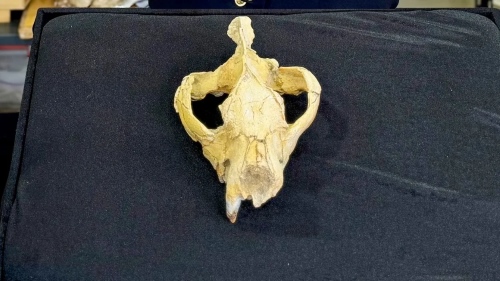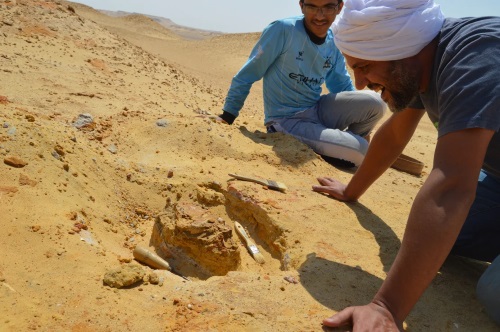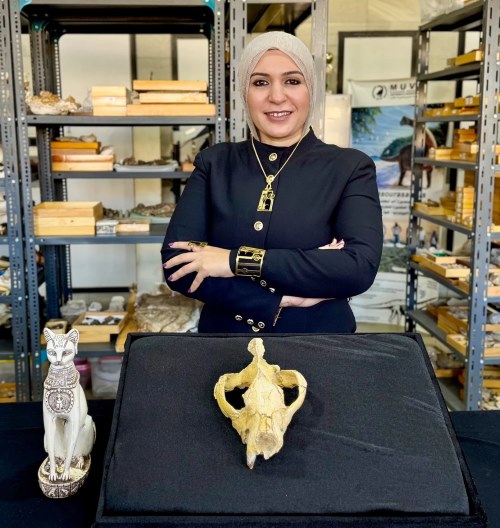A remarkable fossil discovery in Egypt has provided valuable insights into the ancient predator species known as hyaenodonts. This newfound species, named Bastetodon syrtos, once ruled the tropical forests of Egypt around 30 million years ago before mysteriously going extinct. Scientists believe this rare skull fossil could unlock important clues about the evolutionary history and eventual demise of these formidable carnivores.

Source: Courtesy Hesham Sallam
Key Highlights
| Aspect | Details |
| Species Name | Bastetodon syrtos |
| Period | Early Oligocene Epoch (30 million years ago) |
| Discovery Location | Fayum Depression, Western Desert, Egypt |
| Discovery Year | 2020 |
| Research Institutions | Mansoura University Vertebrate Paleontology Center, American University in Cairo, Duke University |
| Significance | The most complete Hyaenodonta skull found in Africa |
The Discovery: A Breakthrough Fossil
A nearly complete skull fossil was unearthed in Egypt’s Western Desert, marking one of the most significant finds related to hyaenodonts. This large carnivorous mammal had features resembling both cats and dogs but belonged to an entirely different lineage. The discovery was led by Shorouq Al-Ashqar, a researcher at Mansoura University, in collaboration with an international team of palaeontologists. The fossil was found in the Fayum Depression, which was once a dense, tropical rainforest.
Features of Bastetodon syrtos
Bastetodon syrtos was named after the ancient Egyptian goddess Bastet, known for her feline-like features. He possessed a shorter snout compared to other hyaenodonts. He had sharp, knifelike teeth, enabling it to deliver powerful bites. It was estimated to be about the size of a leopard and most likely preyed on primates, early hippos, and elephants.
Anatomy and Lifestyle of Bastetodon syrtos
The fossil provides a rare glimpse into the anatomy of these long-extinct predators. Their strong jaw muscles and specialised teeth indicate they were powerful hunters, capable of taking down prey much larger than themselves. The surrounding environment of Fayum, which was once home to an abundance of early mammal species, likely provided ample hunting opportunities for B. syrtos.
| Feature | Details |
| Scientific Name | Bastetodon syrtos |
| Family | Hyaenodonta |
| Diet | Hypercarnivorous (at least 70% meat) |
| Size | Similar to a modern leopard |
| Hunting Strategy | Ambush predator, targeting large mammals |
| Habitat | Once a lush ecosystem, now the Fayum Desert |
| Global Presence | Located in Africa, Asia, Europe, and North America |
Why Is This Discovery Important?
- Unparalleled Fossil Preservation: Most ancient carnivore fossils are fragmented, usually consisting of teeth or skull fragments. This find is one of the most complete skulls ever discovered, allowing for detailed analysis.
- Evolutionary Significance: The fossil helps scientists understand the hyaenodont lineage and how it evolved across continents. Comparative studies with another species, Sekhmetops, suggest that these apex predators were unique to Africa.
- Climate Change and Faunal Turnover: The Eocene-Oligocene boundary (34 million years ago) marked a period of global cooling, leading to mass extinctions. Surviving hyaenodonts adapted to changing environments but eventually lost out to modern carnivores like dogs and cats. Scientists are exploring how climate change, competition, and diet specialisation influenced their decline.

Source: Courtesy Hesham Sallam
Scientific Significance of the Discovery
The discovery of Bastetodon syrtos is a significant step forward in understanding ancient predator-prey dynamics and the evolutionary history of carnivorous mammals. It provides vital clues about how hypercarnivores evolved, spread across continents, and ultimately disappeared.
Expert Insights
“Shorouq Al-Ashqar stated, ‘The discovery of Bastetodon syrtos marks a significant achievement in our comprehension of Hyaenodonta's diversity and global distribution. Our future research aims to delve deeper into their complex evolutionary relationships and adaptations to varying environments across continents."

Source: Courtesy Hesham Sallam
What are the Reasons for the Decline and Extinction of Hyaenodonta?
Despite their dominance for millions of years, Hyaenodonta eventually went extinct between 5 to 7 million years ago. Scientists believe the decline was driven by multiple factors:
1. Climate Change
Shifting global temperatures and environmental changes likely reduced their habitat and food sources.
2. Competition from Emerging Predators
The emergence of feliforms (cat ancestors) and caniforms (dog and bear ancestors) led to the rise of new, more adaptable predatory species. These competitors developed superior hunting strategies, greater stamina, and more efficient use of their environment.
3. Evolutionary Disadvantages
Hyaenodonts had specialized dietary and ecological needs, making them vulnerable to environmental changes. Their lack of adaptability contributed to their eventual extinction. The extinction of hyaenodonts remains a paleontological mystery. This fossil provides a missing link in understanding why these once-successful predators disappeared.
Conclusion
The discovery of Bastetodon syrtos represents a major milestone in paleontology, shedding light on the evolution and extinction of apex predators in prehistoric Africa. The well-preserved skull not only helps reconstruct the species' anatomy and behavior but also offers valuable insights into the effects of climate change and ecological competition on ancient carnivores. Ongoing research on this fossil will continue to unravel the mysteries of the prehistoric world and its lost giants.
Comments
All Comments (0)
Join the conversation